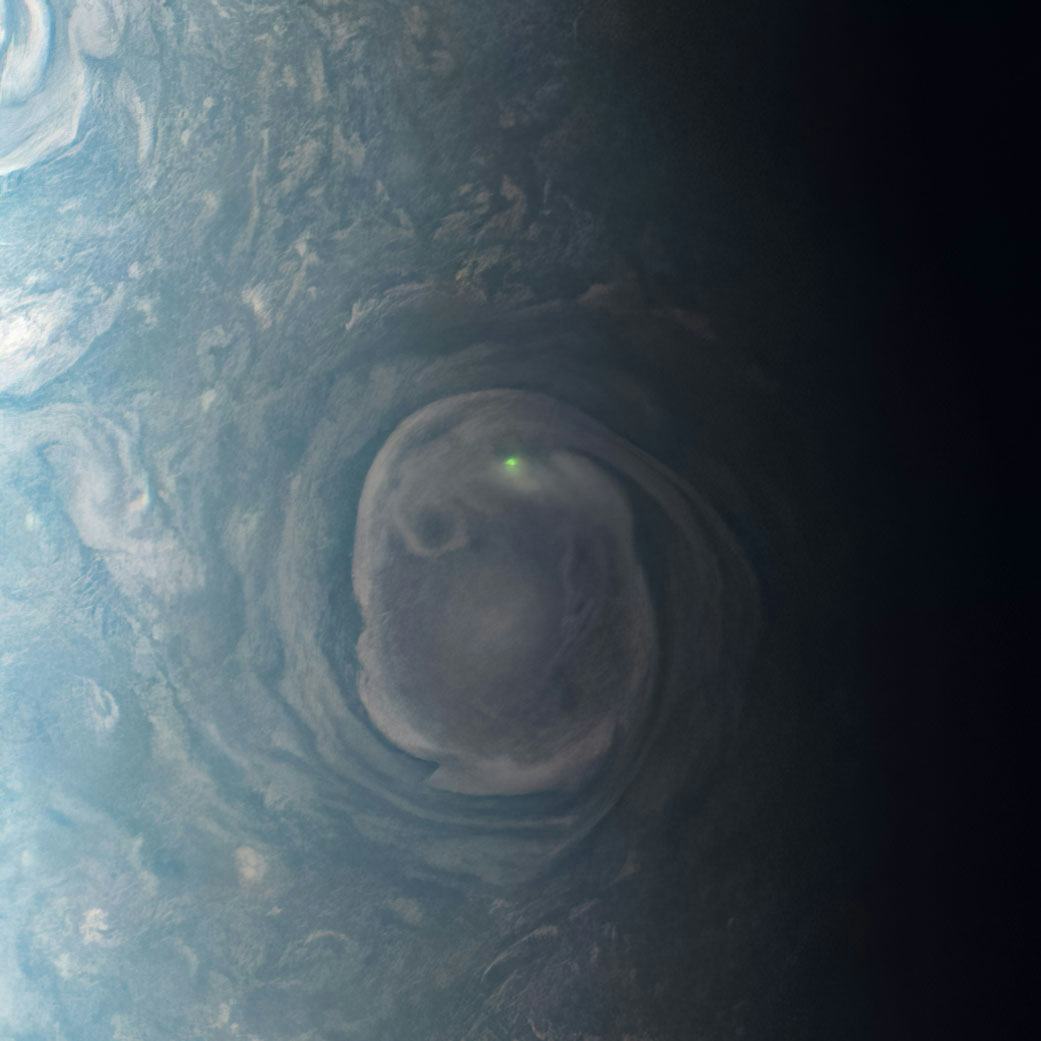
NASA’s Juno spacecraft recently captured this spooky green flash of lightning in a massive storm swirling near Jupiter’s north pole.
The tremendous burst of lightning glows bright against the dark gray vortex of the storm, even from Juno’s vantage point 19,900 miles above the tops of Jupiter’s clouds. Lightning often flashes between the clouds of stormy Jupiter’s higher latitudes, especially in the north. NASA’s Juno spacecraft is helping shed light on the gas giant’s wild alien weather.
Citizen scientist Kevin M. Gill processed the image from Juno’s raw data.
Giant Alien Lightning Bolts

A recent study says lightning works the same way on Jupiter as it does here on Earth — just with about 10,000 times more energy. Storm clouds are turbulent, chaotic places, with updrafts that force water droplets upward and downdrafts simultaneously fling hail and small ice particles downward. As those storm-tossed bits of water and ice brush against each other, the collisions strip electrons away from the water droplets. That turns the storm cloud into a giant battery, with a positive charge at the top and a negative charge at the bottom.
“When the strength of the charge overpowers the insulating properties of the atmosphere, Z-Z-Z-ZAP!” as the National Oceanic and Atmospheric Administration (NOAA) puts it.
Lightning bolts are jagged and forked because the energy travels in a series of short jumps, which often follow a zigzag path instead of a long, smooth leap from cloud to cloud. That’s because the energy being discharged in a lightning bolt tends to follow the easiest path from a negatively charged area to a positively charged one. Scientists have known for years that lightning behaves that way here on Earth, and data from Juno’s Waves instrument recently showed that it does the same thing in the clouds of Jupiter, which are made of a mix of water and ammonia (instead of mostly water like Earth’s clouds).
But there are some big differences. Here on Earth, most lightning strikes happen close to the Equator, but on Jupiter, lightning mostly happens in storms at higher latitudes. The gas giant’s largest and most famous storm, the 10,000-mile-wide Great Red Spot, seems to be all wind and no lightning. Scientists who study alien weather still aren’t sure exactly why that’s the case, but it’s one of the mysteries Juno may eventually help solve.
Our Stormy Solar System
Jupiter was the first planet besides Earth that turned out to have lightning. NASA’s Voyager 1 spacecraft detected the telltale radio signals of lightning strikes in Jupiter’s tremendous storms during its flyby of the gas giant in 1979, and a series of spacecraft since then have studied Jupiter’s lightning in more detail.
The gas giant isn’t the only other world out there with lightning. Saturn and Uranus definitely have lightning to add an eerie ambiance to their storms. Mars probably doesn’t, as its atmosphere is too thin, but the jury is still out; the Mars Global Surveyor satellite has spotted some bright flashes in Martian dust storms that could be lightning or something similar. Saturn’s moon Titan also probably doesn’t have lightning because the chemicals that make up its atmosphere may not lose electrons the same way that water molecules do. Although, the planners of the upcoming Dragonfly mission are taking precautions just in case. Venus and Neptune are also still completely open questions.







